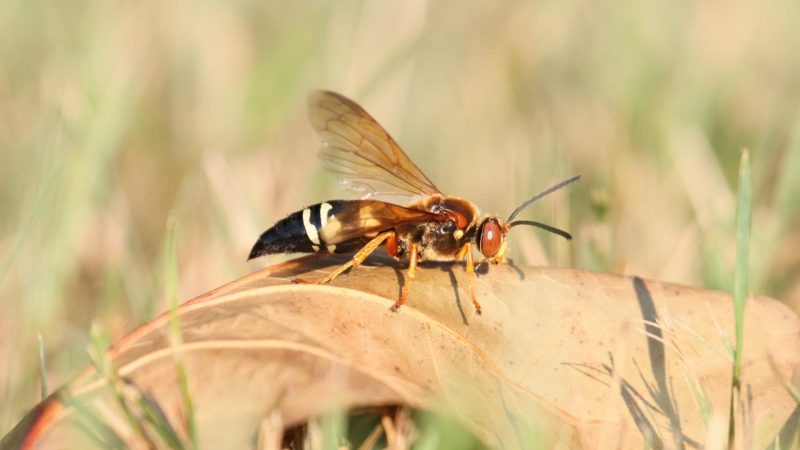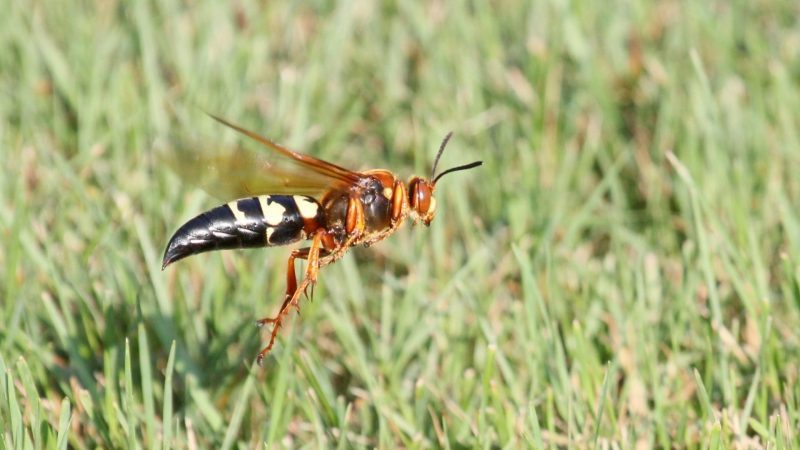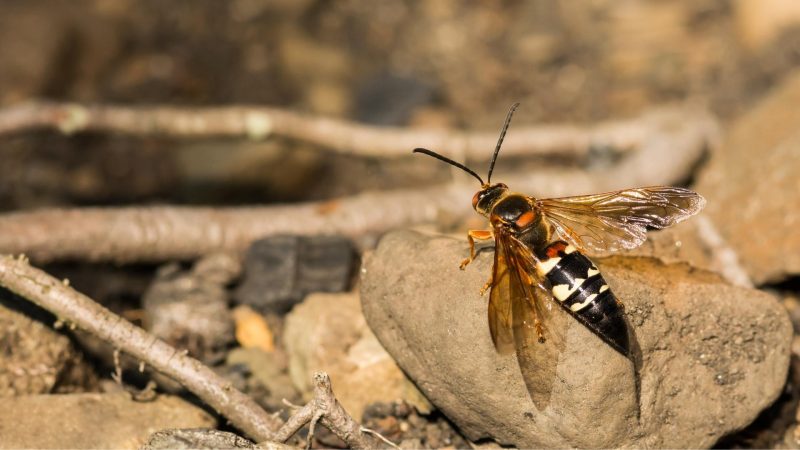Cicada killers are in the order Hymenoptera and are among the largest wasp species found in North America. As their name suggests, they are prolific predators of cicadas (Cicadoidea), which are considered beneficial insects to plants but can also be nuisance pests. But still, they may sting humans.
How dangerous are cicada killer wasps? Cicada killer wasps are not dangerous, to begin with. They may be huge and look scary, but they don’t pose health risks to people. Cicada killers have venom, but it is only designed to paralyze cicadas, not humans. They have no interest in people and are relatively not harmful.
People who know nothing about cicada killers tend to be afraid of them. At first glance, you might think that they will attack you at any time. On the contrary, this wasp species are very unlikely to sting humans.
This article contains everything you should know about cicada killer wasps and how to deal with their presence.
Table of Contents
What Is a Cicada Killer?

Cicada killers are solitary wasps that belong to the family Crabronidae. In general, there are four types of cicada killers – the Western cicada killer (Sphecius grandis), the Pacific cicada killer (Sphecius convallis), the Caribbean cicada killer (Sphecius hogardii), and the Eastern cicada killer (Sphecius speciosus).
Although all cicada killer species can be found in the United States, the most common among them are the Eastern cicada killers, followed by the Western cicada killers.
Western cicada killers are found in Central America and Western America, while Eastern cicada killers are common in the Eastern and Midwest.
What Does a Cicada Killer Look Like?
All cicada killer species have almost the same physical characteristics, except for some color formations.
Cicada killer wasps are usually black with yellow markings (zigzag stripes) on their abdomen and thorax, while their wings are translucent and brownish or orange. They can grow from 1 to 1 1/2 inches long.
Cicada killers are usually mistaken for Asian Giant Hornets, which are also dubbed as murder hornets. However, cicada killers are a bit smaller, and their black head is smaller than their body.
Eastern cicada killers also look like Eastern stizus (Stizus brevipennis), except that their markings have hook-shaped edges.
The Life Cycle of a Cicada Killer

Like most insect species, cicada killer wasps undergo complete metamorphosis, which means they go through four life stages – egg, larva instars, nymph, and adult.
After mating, females dig burrows in the soil to build nests underground, where they lay eggs, which usually occurs in July or August.
Interestingly, female cicada killers hunt for cicadas and bring them to their nests. After paralyzing their prey, they will implant an embryo inside its body, where the eggs are hatched.
Inside, larvae will slowly eat the body until their pupal stage, which usually lasts for about a month. Pupae spend winter inside their cocoon.
How Long Do Cicada Killers Live?
Male cicada killers usually die after mating, while females are very likely to die after laying eggs. Both males and females reach their reproductive maturity once they are 10-12 months old, and the gestation period only lasts for 2-4 days. Their average life span is only 13 months, and there is only one generation per year.
Where Do Cicada Killer Wasps Live?
Cicada killer larvae live independently underground, especially in the loose soil of flower beds or vegetable gardens.
Their nest tunnels (main and secondary) have a diameter opening of about 1 1/2 inches and can reach up to 40 inches deep. A single nest has around 16 cells (or chambers) with 1-2 paralyzed cicadas each.
On the other hand, adults usually live in forests and grasslands, but they can also be found in urban gardens, city parks, and driveways.
The nests are mostly near the trees, where adults capture annual cicadas to feed their young. Fortunately, cicada killer wasps are very unlikely to cause home invasions.
What Attracts Cicada Killer Wasps?

Adult cicada killers are very attracted to dry or well-drained soil, large deciduous trees, golf course sand traps, and sparse lawns.
They also choose sites that are facing southeast and areas covered with grass such as hills, raised banks, and berms. In short, cicada killer wasps are fascinated in areas where cicadas dwell.
Are Cicada Killers Attracted to Light?
Cicada killers are not attracted to light because their preys (cicadas) are also not attracted to it. This is also their main difference with their look-alikes, the European hornets (Vespa crabro).
If you see some insects flying around lights at night that looks like cicada killer wasps, they are likely to be European hornets.
When Do Cicada Killer Wasps Come Out?
Adult cicada killer wasps emerge from their underground nests usually in the early to middle of summer, between the early parts of July and mid-August. By September or October, they will start to die out.
Therefore, It is very unlikely that you see them during the entire winter season up to the last parts of spring.
Do Cicada Killers Fly at Night?
Cicada killers do not fly at night. Instead, they rest underground or maintain their nests. These wasps are diurnal, which means that they are most active during the day.
They can be seen flying around on plants and trees from early morning to dusk. Nonetheless, cicada killer wasps tend to avoid people and animals.
What Do Cicada Killers Eat?

As mentioned earlier, cicada killer larvae eat cicadas and are insectivores. Once they become adults, they will emerge from their nest and feed on nectar from flowers and other sweet plant juices.
Nevertheless, adult cicada killers don’t eat the entire plant and are therefore considered nectarivores, not herbivores.
Do Birds Eat Cicada Killer Wasps?
Birds eat cicada killer wasps and other wasp species as well. Among the birds that feed on cicada killers are roadrunners, mockingbirds, and kingbirds.
In many cases, these birds aim for the females carrying cicadas for their young. Using their bill, they snatch cicadas from them but may also eat cicada killers.
Do Cicada Killers Sting?

Male cicada killers don’t sting humans simply because they don’t have stingers, which means that they are completely harmless. On the other hand, female cicada killers can sting humans, but they rarely attack people. They use their sting mainly to inject venom to cicadas, thus paralyzing them but not killing them.
Despite their scary looks and huge size, a cicada killer sting to humans is not dangerous since they don’t carry diseases.
Although stings can be quite painful, especially to people who are allergic to them, they don’t usually require medical attention. Also, cicada killers sting people only if roughly handled or threatened.
How to Destroy a Cicada Killer Nest?
Finding a single cicada killer nest away from your property may not be cause for alarm. But once it is around your plants or vegetable garden, and more nest tunnels are slowly appearing, you might want to control them.
Otherwise, they can disrupt their roots. Here are some simple ways to destroy a cicada killer nest:
- Cicada killers hate wet soil. Therefore, water your plants regularly and thoroughly or pour water directly on the nest opening until all the wasps leave their nest. Then, cover the opening with soil.
- Get your soil tested in a laboratory, so you will know the correct lime and fertilizer to apply.
- To help promote thick turf growth, add new grass seeds. For vegetable gardens, plant more vegetables, especially before the breeding season.
- To help prevent the next generation from building nests, apply mulch at about 3 inches deep on your garden beds.
How to Kill Cicada Killers?
Cicada killers are considered great pollinators and help reduce the annoying cicada population. But still, they can be bothersome pests, and their nests can damage your turf and small plants. If your last resort is to kill cicada killer wasps, here are some things you can do, aside from those mentioned above:
- Apply pyrethroid insecticides directly on the entrance of active nests. Products such as Southern Ag Natural Pyrethrin Concentrate are organic chemicals and are safe for plants.
- Alternatively, apply insecticide dust with Carbaryl such as Garden Tech Dust Bug Killer Shaker Canister also directly on the opening of cicada killer nests. But beware, although they don’t penetrate plant tissues, they can also kill other beneficial insects.
- You may also use aerosol sprays such as Black Flag Foaming Wasp & Hornet Killer. But instead of spraying them on the nest, you must spray directly on them.
- Residual insecticides with Cypermethrin also work effectively against cicada killer larvae. One of the most trusted products is Demon Max Insecticide Pint 25.3% Cypermethrin.
- To kill lots of cicada killers, take action at night since adults are usually out in the day. Always read labels and instructions before using insecticides.
How to Get Rid of Cicada Killer Wasps Naturally?
Once again, killing cicada killer wasps is not advisable unless they start to cause trouble in your garden. As mentioned earlier, they have a fairly short life span and are only seasonal insects. But if you think you should kill them and you don’t want to use insecticides, here are some natural ways to get rid of cicada killers:
- With the use of a badminton racket, swat cicada killers that are flying around or coming out of the nest.
- Plug a piece of a stick inside the tunnel and remove the pile of dirt from the nest.
- Place cicada wasp traps such as RESCUE! Wasp TrapStik near their nest, especially during summer.
Summary
Cicada killer wasps are considered beneficial insects more than being nuisance pests. In fact, they will not bother you as long as you don’t bother them. Cicada killers may cause some damage to your plants only if they are in huge numbers. When dealing with them, always wear safety gloves to avoid getting stung.